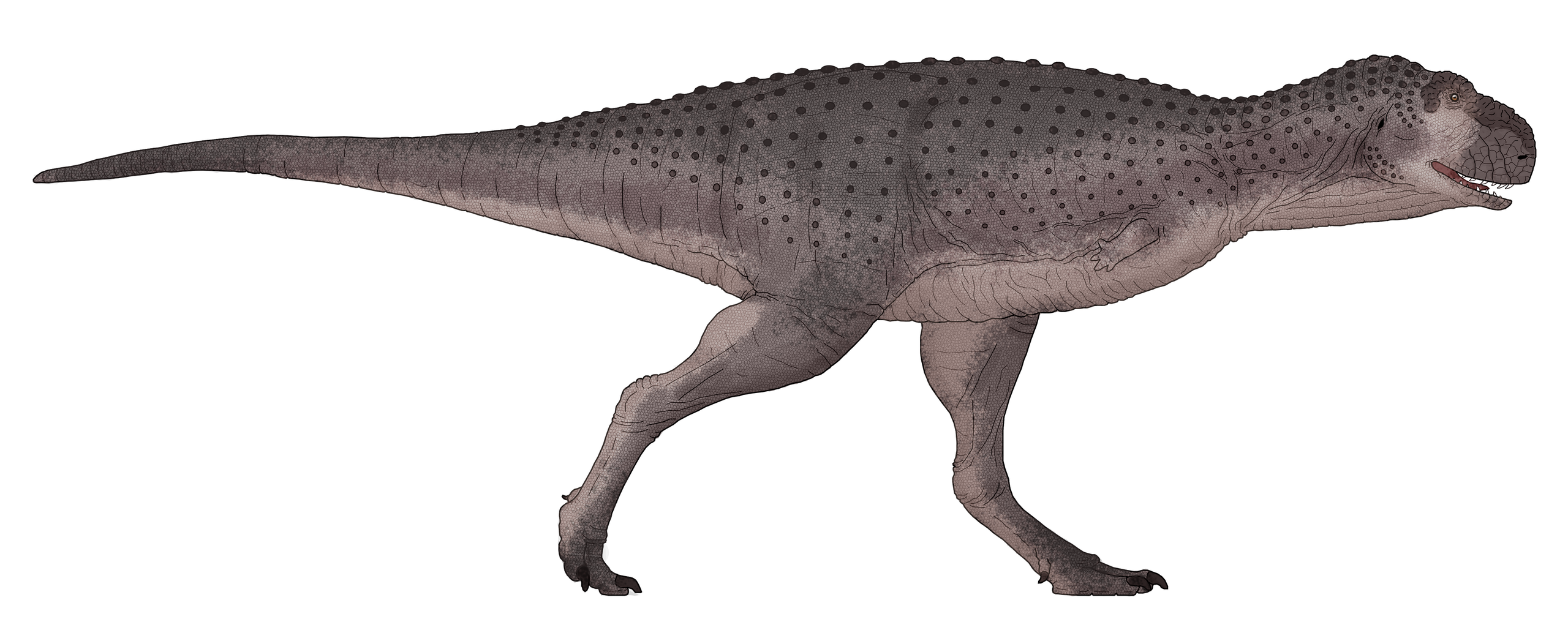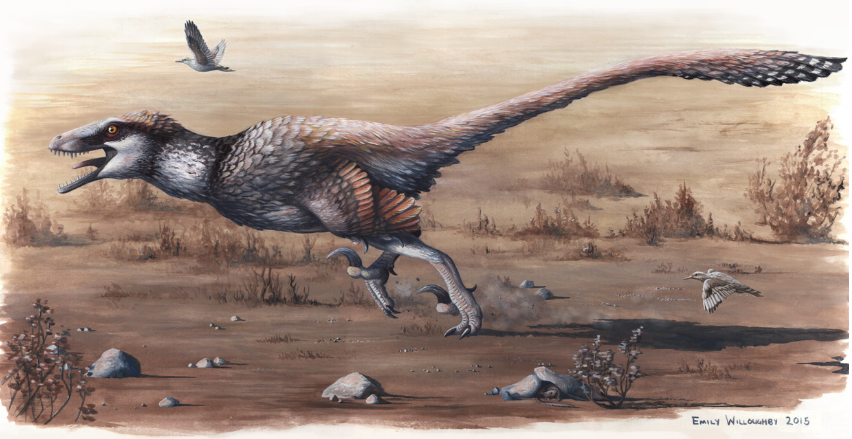|
|
Post by Life on Oct 20, 2017 21:11:25 GMT 5
|
|
|
|
Post by Infinity Blade on Jul 20, 2018 4:21:15 GMT 5
A new southern Laramidian ankylosaurid, Akainacephalus johnsoni gen. et sp. nov., from the upper Campanian Kaiparowits Formation of southern Utah, USAJelle P. Wiersma, Randall B. Irmis A partial ankylosaurid skeleton from the upper Campanian Kaiparowits Formation of southern Utah is recognized as a new taxon, Akainacephalus johnsoni, gen. et sp. nov. The new taxon documents the first record of an associated ankylosaurid skull and postcranial skeleton from the Kaiparowits Formation. Preserved material includes a complete skull, much of the vertebral column, including a complete tail club, a nearly complete synsacrum, several fore- and hind limb elements, and a suite of postcranial osteoderms, making Akainacephalus johnsoni the most complete ankylosaurid from the Late Cretaceous of southern Laramidia. Arrangement and morphology of cranial ornamentation in Akainacephalus johnsoni is strikingly similar to Nodocephalosaurus kirtlandensis and some Asian ankylosaurids (e.g., Saichania chulsanensis , Pinacosaurus grangeri , and Minotaurasaurus ramachandrani); the cranium is densely ornamented with symmetrically arranged and distinctly raised ossified caputegulae which are predominantly distributed across the dorsal and dorsolateral regions of the nasals, frontals, and orbitals. Cranial caputegulae display smooth surface textures with minor pitting and possess a distinct conical to pyramidal morphology which terminates in a sharp apex. Character analysis suggests a close phylogenetic relationship with N. kirtlandensis , M. ramachandrani , Tarchia teresae , and S. chulsanensis , rather than with Late Cretaceous northern Laramidian ankylosaurids (e.g., Euoplocephalus tutus , Anodontosaurus lambei , and Ankylosaurus magniventris ). These new data are consistent with evidence for distinct northern and southern biogeographic provinces in Laramidia during the late Campanian. The addition of this new ankylosaurid taxon from southern Utah enhances our understanding of ankylosaurid diversity and evolutionary relationships. Potential implications for the geographical distribution of Late Cretaceous ankylosaurid dinosaurs throughout the Western Interior suggest multiple time-transgressive biogeographic dispersal events from Asia into Laramidia. peerj.com/articles/5016/ peerj.com/articles/5016/
|
|
|
|
Post by Infinity Blade on Aug 23, 2018 17:13:25 GMT 5
|
|
|
|
Post by creature386 on Sept 3, 2018 1:19:03 GMT 5
|
|
|
|
Post by Grey on Sept 26, 2018 15:51:44 GMT 5
|
|
Dakotaraptor
Junior Member
  Used to be Metriacanthosaurus
Used to be Metriacanthosaurus
Posts: 193 
|
Post by Dakotaraptor on Oct 22, 2018 22:09:42 GMT 5
|
|
|
|
Post by creature386 on Oct 23, 2018 18:48:20 GMT 5
TL;DR:This could warrant its thread, considering our interest in this animal.
Scaling from the Rebbachisaurus weight I find on Wikipedia (7 metric tons for 14 m), it probably weighed a bit over 60 t. Still one of the largest dinosaurs, but not as big as we used to think.
|
|
stomatopod
Junior Member
  Gluttonous Auchenipterid
Gluttonous Auchenipterid
Posts: 182
|
Post by stomatopod on Oct 24, 2018 7:11:22 GMT 5
I wish I could access my old posts on CF and my calculations on that matter, but yeah I am all for a thread about it.
|
|
|
|
Post by Infinity Blade on Nov 23, 2018 21:13:30 GMT 5
|
|
|
|
Post by theropod on Nov 24, 2018 5:03:19 GMT 5
^Yes, that’s the same dicynodont described by Dzik et al. 2008 (the specimen numbers in the figure caption match), and yes it’s definitely an up-size, the original description talked of it being rhino-sized, now it’s suddenly elephant-sized. They seem to have found additional material including an 80cm[!] femur and 94cm[!] scapula. I did a rough 3D model of the skeletal included in the paper back then and it came out at around 2t, give or take a few hundred kilograms (that was with a 56cm femur and 49cm humerus). Of course, lacking a dorsal view complicated things, and I was really just ballparking, but even then, that was probably the largest dicynodont known back then.
The skeletal in the new paper is definitely bigger than the one in the old preliminary description when based on the scale bar, consistent with the dimensions given in the abstract (and also having a much shorter tail). 9t still seems excessive, but for the new skeletal I’m actually getting close to 6t, using a simplified model with a circular cross-section and no limbs. That is ignoring most of the limbs, but also probably vastly exaggerating the width of the skull and neck (1.1m, while Dzik et al estimated 0.47m for the specimen they reported, assuming that belonged to the smaller femur it should still only be 67cm for the larger specimen), which might cancel each other out somewhat, but obviously that’s also just ballparking. This could be improved vastly with some more material preserving good kannemeyriid dorsal views, so feel free to let me know if you find any.
I’m a bit sceptical about the 9t figure since it’s based on limb-bone scaling (this thing simply seems to have ridiculously robust limbs), but it does seem like the largest specimen really must have been the size of a Loxodonta bull, at least mass-wise. That puts it in the same size-region as the largest Triassic sauropodomorphs (e.g. Lessemsaurus at a recently estimated 7t, though that particular figure should also be verified), and, remarkably, is considerably heavier than the largest adult Plateosaurus (~10m and 4t), which should really make us revisit our preconceptions about Norian ecosystems in Europe.
The thought of something with the size and built of an adult Triceratops running around in the upper Triassic…quite unexpected, especially since we thought sauropodomorphs were already dominating at that poing. And once more, makes one wonder what on earth could have been around to hunt these guys.
Dzik, J., T. Sulej, and G. Niedźwiedzki. 2008: A dicynodont-theropod association in the latest Triassic of Poland. Acta Palaeontologica Polonica 53:733–738.
|
|
|
|
Post by Infinity Blade on Nov 24, 2018 6:49:44 GMT 5
Well, I could try, but I think it's doubtful we'll find a good dorsal view for this family, especially if my rather cursory search was any indication of the fruitfulness thereof. And not only are kannemeyeriids not exactly the most popular fossil animals ever, I doubt they're the most extensively studied too. I have a question: would the "tusks" of this dicynodont really be keratinous extensions of those bony protrusions pointing downwards from the upper beak (sort of looks like it to me; link)? This was never clear to me. Dicynodonts are described as having two tusks (it's in the name too), except while some dicynodonts (e.g. Lystrosaurus) genuinely do seem to have tusks, others have "tusks" that just seem to be extensions of their beak (so more like a horn than a tusk; e.g. Placerias, or Lisowicia here), and some seem to lack tusks or "tusks" altogether (e.g. Ischigualastia). |
|
|
|
Post by theropod on Nov 24, 2018 18:56:38 GMT 5
From what I have seen and heard, dicynodonts should have pretty barrel-shaped trunks, however I sadly didn’t take useful photographs when I had the opportunity. Also, the real size of their large herbivorous guts is a source of uncertainty.
Those bony protrusions are merely part of the jawline, from which, where they were present, the tusks would have erupted (I am not sure to what extent some Kannemeyriforms may not have had any though). The tusks themselves seem to usually not be preserved (as is the case in Lisowicia). So the actual tusks themselves would actually be real tusks, i.e. teeth, not parts of the beak, merely set on a protrusion of the maxilla so they would face forwards.
|
|
|
|
Post by creature386 on Dec 31, 2018 19:01:39 GMT 5
 This is Thanos. Marvel supervillain, space God, wielder of the Infinity Gauntlet and overall maniac who got his ass kicked by Darkseid in the last DeathBattle episode.  This is also Thanos… …simonattoi. ~6 m long Late Cretaceous Brazilian abelisaurid. The holotype consists of an almost complete axis fused with an axial intercentrum. It was likely a subadult or adult at the time of its death. According to the authors, T. simonattoi is more derived than other abelisaurids and was not the apex predator of its ecosystem which it shared with a large megaraptoran. Here's the paper: www.tandfonline.com/doi/abs/10.1080/08912963.2018.1546700?journalCode=ghbi20 |
|
|
|
Post by creature386 on Jan 11, 2019 17:11:06 GMT 5
|
|
|
|
Post by theropod on Jan 11, 2019 21:24:53 GMT 5
|
|












